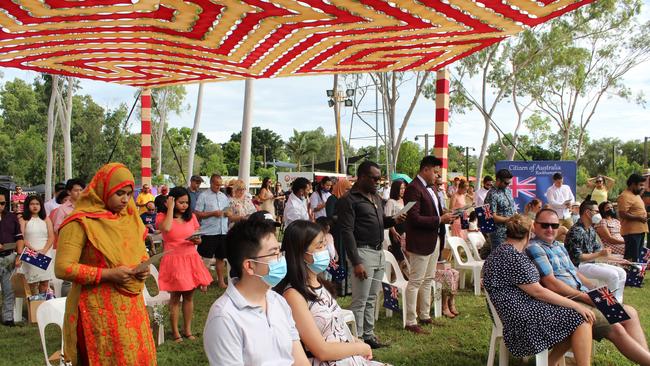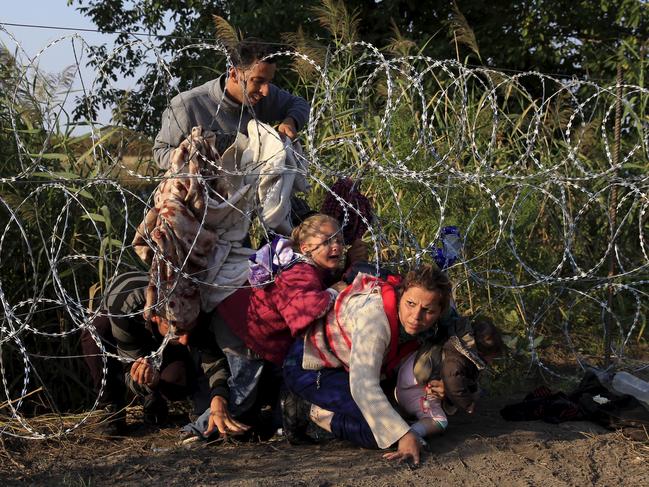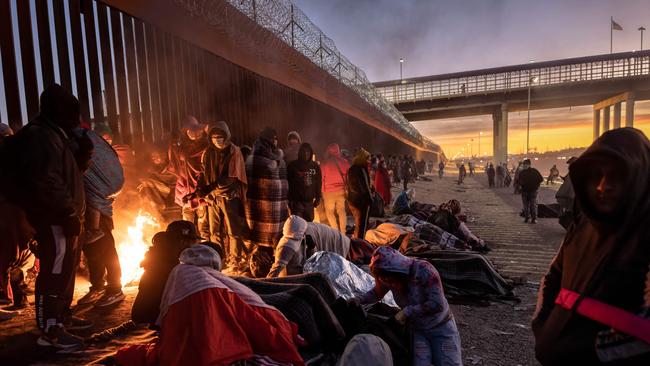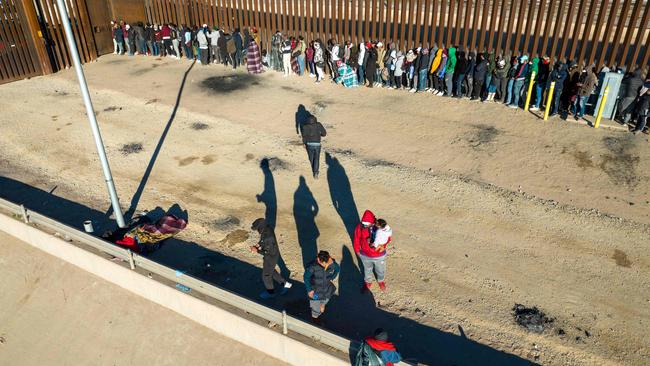‘One and free’ we might be, but our national unity is increasingly fragile

Yet the latest census results show we are the most ethnically diverse nation in the Western world, with half the population either born overseas or having an overseas-born parent.
In the US, 13.6 per cent of people are foreign-born, in the UK it’s 13.7 per cent, and in Australia it’s a whopping 30 per cent.
The past few decades, especially after the lifting of White Australia, have unleashed a steady wave of immigrants distant from the Anglo-Saxon creed. I am a child of these immigrants, my parents travelling in 1980 from Bangladesh.
The public, by and large, values such diversity. Repeated surveys have shown Australia is supportive of the notion of multiculturalism, while not familiar with its political meaning. But it remains critical that emerging minority groups and successive waves of immigrants embrace the common norms of society.
Arrivals who become permanent residents must also feel they have equal access to the relevant social and economic resources.
But as binding identities linked to nationalism, religion or even of a singular national story all come under threat, the questions of what we mean by integration and what exactly we are integrating into become especially relevant.

This is especially true when a large chunk of what we hear about the national story is of guilt, shame and irredeemable racism. If all a migrant hears are tales of horrors veering from genocides, colonialism and oppression then outsiders may see little of value to embrace that.
Applying integration only to immigrants is also too narrow at a time when social connections are dissipating across the board.
As argued by Brendan Cox, husband of murdered British politician Jo Cox, the term can equally apply to the rising cohorts of lonely old people to the teenagers suffering worsening mental health problems.
The problem overlaps with the question of how to build meaningful communities for everyone. Traditional identities linked to place, people and binding institutions are now a rarity.
“Our countries look less like republics of citizens today than assemblies of consumers and web surfers glued to their screens,” writes social theorist Mark Lilla.
The term ”integration” has a long history within Western democracies, a marker of the shift from a white, Christian-dominated populace to polyglot multicultural nations.
This history is all the more apparent in the wake of the death of Queen Elizabeth, a world-historical event that has laid bare our fundamental British, Christian underpinnings.
Watching all manner of leading Australian figures pronounce their fealty to the new King was like exposing an invisible but uncut umbilical cord to our roots.
We are in a better position than many parts of Europe in creating a sense of belonging not inextricably linked to ethnicity or a cultural history. We have the advantage of having a civic-based identity more accessible to migrants, albeit a relatively weak one. Our success story has been heavily buttressed by resource-driven prosperity.
The higher levels of diversity still generate conflicting ideas of how best to manage it. Flashpoints over asylum seekers, crime with an ethnic hue, and extremism bring a fever pitch to this polarisation.

Integration was a term that rose to the fore amid the threat of terrorism, a spectre which resurfaced in the furore about Islamic State brides. The term became tinged with connotations of racism among ethnic groups, especially Muslims, along with large sections of the left.
Local versions of the conservative party retreated from promoting integration too enthusiastically, mixing any policies around learning English or citizenship classes with proclamations of Australia’s success in integrating migrants. This fear is a long way from past policies encouraging assimilation, beginning in the 1950s, when arrivals were expected to shed their pre-existing cultural identities and conform to the national culture.
Modern ideas of integration involve immigrants and host societies co-operating to form a supportive base for the entire population.
While there is no definitive index or measure for integration, indicators include citizens’ views on trust of their neighbours, their sense of belonging, and their civic and political participation. Australia scores well among all measures, although participation has steadily declined over several decades.
In spite of a trust deficit during the pandemic which saw a big rise of dobbing in other citizens, levels are likely to return to where they were before the pandemic.

On measures of education, Australia does especially well, with new migrants doing at least as well as the broader population. Certain groups, such as those of Asian, origin do better.
A 2011 paper for the Centre for Independent Studies by Oliver Hartwich argues it is primarily the strict selection criteria that has driven Australia’s success story and not because Australia does anything active to integrate migrants.
The highly skilled migrants we select tend to be more ambitious for their children. This success can lead to inertia around the topic of doing anything interventionist once migrants have arrived.
Other countries in Europe have been less selective in their immigration intake. Who could forget Angela Merkel’s embrace of Syrian refugees at the height of the conflict in 2015, emotionally sparked by images of a dead child on the beach.
The recent success of anti-immigration parties across Europe, from Sweden to Italy, is the legacy of the humanitarian overreach creating widespread resentment regarding crime and welfare dependency among asylum seekers.
Meanwhile, in America there is considerable debate about altering the US immigration policy. Immigration policy expert and Georgetown professor Justin Gist argues that America is an outlier regarding trends in immigration policy.

‘We found that the world has largely shifted to immigration policy as an economic instrument (rather) than a statement of values,” says Gist.
He makes the point that few countries incorporate immigration as a statement of values, yet this is exactly what the era of terrorism raised. There has been a push to implement a skills-based entry system similar to Australia and Canada.
America has the world’s most illegal immigrants, significantly worse social mobility than Australia, and large pockets of ethnic underclass scattered across its major cities.
But what it does have compared to Europe is a strong civic identity, as compared to the more pronounced cultural identities of mainland Europe. It is more difficult to feel German as a second-generation Turk, or French as an immigrant Moroccan than it is to identify as Asian-American.
These are exactly the types of problems Australia has managed to avoid. Like so many aspects of Australia, we sit neatly between the welfare states of Europe and the laissez-faire economies of Anglo-America.
In areas of national identity, we are a much younger country than Britain or the US and, as events since the Queen’s death have shown, are still in the process of navigating our relationship to the motherland. But our relative strengths in terms of great prosperity, an inclusive, egalitarian culture and fussy migrant selection conceals an apparent disinterest in crafting a stronger, civic identity.
Terrorism, especially the home grown variety, highlighted that some citizens could be outwardly well integrated, economically secure, speaking and acting much like the majority population, yet their emotional ties could be linked to supranational identities characterised by contempt towards the host culture.
The era was a culmination of the driving force within politics which theorists like Francis Fukuyama identify as the concept of “thymos”, best translated in modern terms as dignity, and the animating energy around what we call identity politics.
There is a strong psychological edge to the political as it elevates the inner self, desires and the subjective experience. This is especially true if you are deemed to be part of a marginalised group who claim a unique consciousness that requires accommodating. Such trends retard the formation of identities accessible to large, diverse groups. The emotional world takes precedence over reasoned deliberation.
This is a weakness of liberalism which sees society as a collection of individuals acting with reasoned autonomy that it can minimise the desire for belonging, a space the politics of identity fills.
The recent Jobs and Skills Summit of the federal Labor government was significant as it pointed to a return of the politics of capital versus labour. The left has struggled to reinvent itself economically in the wake of the destruction of policies tied to radical egalitarianism, especially while the working classes have become richer, largely resembling the middle classes.

A new Labor government has already flagged changes to immigration policy. The Minister for Home Affairs has called for a greater priority towards ensuring migrants have a pathway towards permanent residency, partly to turn over the growth in temporary migrants.
But there is no mention of integration, which is primarily about where successive generations are at compared with local averages.
A notable marker of local success is an especially good history regarding mixed marriage.
A 2011 study found 60 per cent of Australians intermarry in the second generation. This is in contrast to Britain where South Asians have especially low rates of marriage outside of their ethnic group. In the US it was 40 per cent. Even in Canada, which is often lauded for its multicultural success, the intermarriage rate was only 22 per cent.
This aspect is partly driven by minorities not wishing to self-segregate. They usually move in search of better housing and schools in striving for upward mobility. However migrants, even when they do move, are much more likely to do so into already diverse areas. This gives an insight into the growing urban/rural fracture.
Rural areas are likely to have largely white populations with relatively limited contact with ethnic groups. They are then most likely to feel a level of cultural anxiety with a stronger attachment to national traditions and values.
This overlaps with the notion of white flight, where big cities become filled with immigrants, knowledge workers and essential service staff while others undertake sea or tree changes to regional areas.
Highly diverse cities then align with the politics of the left with weaker attachments to national traditions. The result is that there are fewer institutions bringing us together.
Another important trend that may hamper healthy integration is that even a small preference for choosing those quite similar to ourselves, over a long period of time, can lead to strong levels of segregation.
We can freely choose to be with people like us, even as we move among those outwardly different, like ships in the night.
A notable example is in our schools. For all our success in integrating migrants through education, research by UTS academic Christina Ho illustrates cities such as Sydney have among the most ethnically segregated schools in the world.
The sheer degree of change, freedom and choice can leave people unmoored, searching for structured community. This makes people innately vulnerable to those who are able to speak to them, elevating their sense of being part of an important, unrecognised group.
But all of us have multiple identities shaped by occupation, race, nationality or hobbies.
The modern challenge of multicultural democracies like Australia is to build broad, integrative identities, making it less attractive to splinter off into smaller divisions.
The creedal national identities can’t be built around personal characteristics, ethnicity or religious convictions. While past influences need to be acknowledged, core values and beliefs must be paramount.
Public policy can then be used to assimilate newcomers into such ideals.
Integration into a national culture becomes more difficult as the numbers of immigrants rise relative to the native population, as is the case for Australia now.
As specific communities become larger, they become more self-sufficient and have lesser need to connect to groups outside of themselves. Shared national sacrifice around policy areas such as climate change, NDIS or aged care spending become tougher to rally the entire community around.
In spite of the various battlefronts, the bigger war is around building a sense of pride and belonging around an inclusive national story. This is especially difficult in Australia where there is a stigma around patriotism.
But the death of the Queen may provide the fertile ground to do just that. While some of it may be centred around any future republic, this may provide an excuse to do the necessary outpouring around traits such as a unique, larrikin egalitarianism, ties to a rugged landscape, and an inspiring story of a country rising from modest beginnings to become the most peaceful, prosperous place on earth.
This is an edited extract from Essays for Australia published by the Institute of Public Affairs.



The term integration has become a dirty word without a policy home.